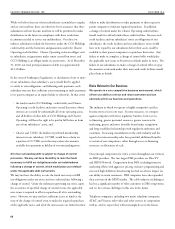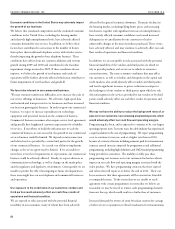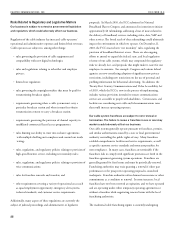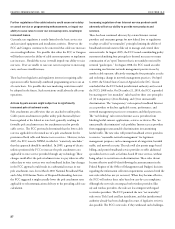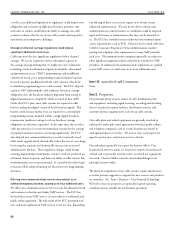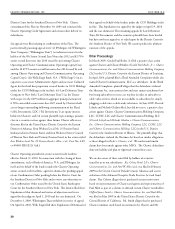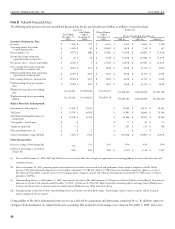Charter 2010 Annual Report Download - page 41
Download and view the complete annual report
Please find page 41 of the 2010 Charter annual report below. You can navigate through the pages in the report by either clicking on the pages listed below, or by using the keyword search tool below to find specific information within the annual report.
as well as any additional legislation or regulation, could impose new
obligations and restraints on high-speed Internet providers. Any
such rules or statutes could limit our ability to manage our cable
systems to obtain value for use of our cable systems and respond to
operational and competitive challenges.
Changes in channel carriage regulations could impose
signicant additional costs on us.
Cable operators also face significant regulation of their channel
carriage. We can be required to devote substantial capacity to
the carriage of programming that we might not carry voluntarily,
including certain local broadcast signals; local public, educational
and government access (“PEG”) programming; and unaffiliated,
commercial leased access programming (required channel capacity
for use by persons unaffiliated with the cable operator who desire
to distribute programming over a cable system). e FCC adopted
a plan in 2007 addressing the cable industry’s broadcast carriage
obligations once the broadcast industry migration from analog to
digital transmission is completed, which occurred in June 2009.
Under the FCC’s plan, most cable systems are required to offer
both an analog and digital version of local broadcast signals. is
burden could increase further if we are required to carry multiple
programming streams included within a single digital broadcast
transmission (multicast carriage) or if our broadcast carriage
obligations are otherwise expanded. At the same time, the cost that
cable operators face to secure retransmission consent for the carriage
of popular broadcast stations is increasing significantly. e FCC
also adopted new commercial leased access rules (currently stayed
while under appeal) which dramatically reduce the rate we can charge
for leasing this capacity and dramatically increase our associated
administrative burdens. ese regulatory changes could disrupt
existing programming commitments, interfere with our preferred use
of limited channel capacity, and limit our ability to offer services that
would maximize our revenue potential. It is possible that other legal
restraints will be adopted limiting our discretion over programming
decisions.
Offering voice communications service may subject us to
additional regulatory burdens, causing us to incur additional costs.
We offer voice communications services over our broadband network
and continue to develop and deploy VoIP services. e FCC has
declared that certain VoIP services are not subject to traditional state
public utility regulation. e full extent of the FCC preemption of
state and local regulation of VoIP services is not yet clear. Expanding
our offering of these services may require us to obtain certain
additional authorizations. We may not be able to obtain such
authorizations in a timely manner, or conditions could be imposed
upon such licenses or authorizations that may not be favorable to
us. e FCC has extended certain traditional telecommunications
carrier requirements, such as E911, Universal Service fund collection,
CALEA, Customer Proprietary Network Information, number
porting and telephone relay requirements to many VoIP providers
such as us. Telecommunications companies generally are subject to
other significant regulation which could also be extended to VoIP
providers. If additional telecommunications regulations are applied
to our VoIP service, it could cause us to incur additional costs.
unresolved staff Comments.
None.
Properties.
Our principal physical assets consist of cable distribution plant
and equipment, including signal receiving, encoding and decoding
devices, headend reception facilities, distribution systems, and
customer premise equipment for each of our cable systems.
Our cable plant and related equipment are generally attached to
utility poles under pole rental agreements with local public utilities
and telephone companies, and in certain locations are buried in
underground ducts or trenches. We own or lease real property for
signal reception sites, and own our service vehicles.
Our subsidiaries generally lease space for business offices. Our
headend and tower locations are located on owned or leased parcels
of land, and we generally own the towers on which our equipment
is located. Charter Holdco owns the land and building for our
principal executive office.
e physical components of our cable systems require maintenance
as well as periodic upgrades to support the new services and products
we introduce. See “Item 1. Business – Our Network Technology.”
We believe that our properties are generally in good operating
condition and are suitable for our business operations.



